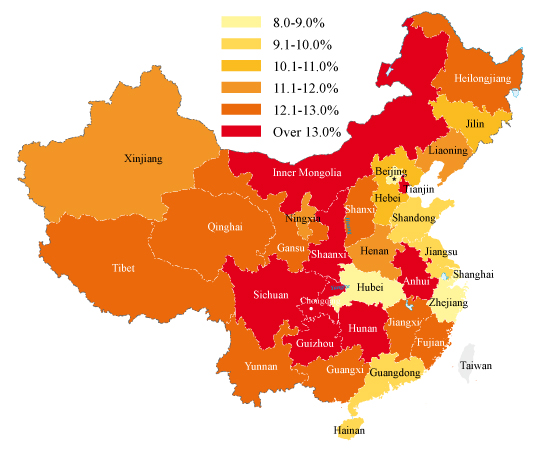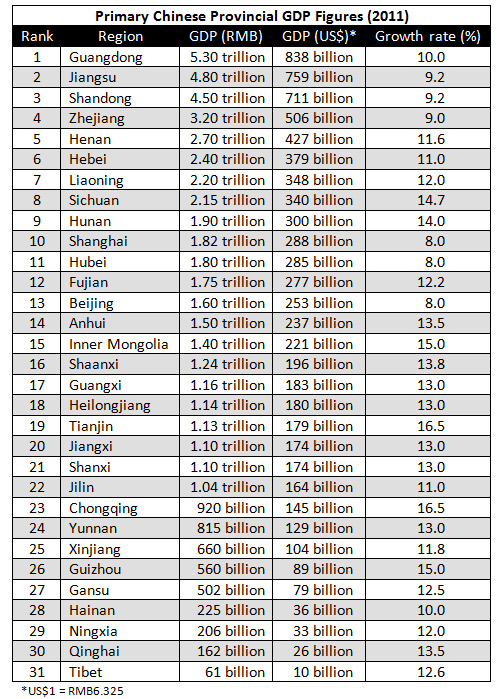China’s Provincial GDP Figures in 2011
*Update (May 16, 2013): China’s Provincial GDP Figures in 2012
Two-thirds of China’s provinces report GDP figures over RMB1 trillion (US$158 billion) in 2011
By Julia Gu
Jan. 27 – Preliminary statistics show that China’s GDP grew at a robust 9.2 percent in 2011 to RMB47.16 trillion (US$7.26 trillion), the National Bureau of Statistics (NBS) said last week at a press conference.
While this rate represents a drop of 1.2 percent compared to the 10.4 percent GDP growth experienced in 2010, last year’s growth rate was still 1.2 percent above the 8 percent year-on-year growth target set at the beginning of 2011.
NBS Chief Ma Jiantang told reporters that China’s economy grew 9.7 percent and 9.5 percent year-on-year for the first and the second quarters of 2011, respectively. However, the economy slowed down to 9.1 percent in the third quarter, which was followed by growth of 8.9 percent in the fourth quarter.
Though the data show a decline, Ma said that China’s economy is still growing stronger than expected and hailed China’s economic performance in 2011 as a “good start” for the country’s 12th Five-Year Plan, from 2011 to 2015.
“Although GDP growth fell on a quarterly basis, it was within a reasonable range and the country’s economic fundamentals were not changed. We have confidence for 2012’s growth,” said Ma.
“We should no longer be obsessed with the speed of growth,” said Lu Zhongyuan, deputy director of the Development Research Center of the State Council.
Lu predicted the expansion of China’s GDP growth will slow down to 8.5 percent in 2012. A report released by the Center for Forecasting Science under the Chinese Academy of Sciences also forecasts economic growth of 8.5 percent for this year.
Provincial GDP Statistics
When breaking down China’s 2011 statistics, an impressive 22 provinces reported GDP figures in excess of RMB1 trillion (US$158 billion), according to the yearly economic reports of local governments. It should again be noted, however, that these are preliminary statistics and official statistics will not come out until later this year.


South China’s Guangdong Province, the longtime leader of the Pearl River Delta’s bustling economy, is the country’s first region to claim a GDP over RMB5 trillion, increasing 10 percent year-on-year in 2011. Fixed asset investment into Guangdong grew by 17.6 percent last year to RMB1.69 trillion (US$267 billion) and the province’s trade volume amounted to US$913.48 billion, expanding 37 percent from 2010. Provincial Governor Zhu Xiaodan said that Guangdong will slow GDP growth to 8.5 percent in 2012, and will be more focused on the quality of economic development.
In East China, Jiangsu Province’s GDP grew 9.2 percent to RMB4.8 trillion (US$759 billion) in 2011, according to the provincial government’s report. Jiangsu’s GDP per capita reached US$9,500, and the region’s used FDI amounted to US$32 billion.
Deputy Governor of Shandong Province Wang Junmin told reporters that recent data show Shandong’s GDP came in at RMB4.5 trillion (US$711 billion) in 2011. Meanwhile, Zhejiang Province, a major manufacturing hub in the Yangtze River Delta, reported that in 2011, the province’s GDP increased by 9 percent to RMB3.2 trillion (US$506 billion).
Economic data from Sichuan show that it is the first province from West China to join the “2-trillion” club, with a GDP of RMB2.15 trillion (US$340 billion), provincial authorities said. Official figures show that the province’s growth rate was 14.7 percent year-on-year, more than 5 percent higher than the national average. Seven cities in Sichuan each reported GDP levels of over RMB100 billion last year, namely Chengdu RMB680 billion, Mianyang RMB118.91 billion, Deyang RMB113.75 billion, Yibin RMB109.12 billion, Nanchong RMB102.95 billion, Dazhou RMB101.18 billion and Liangshan RMB100 billion.
These annual reports from the local authorities reveal that while China’s economic growth slowed slightly, the country managed to avoid any major economic shocks and, instead, exceeded the national growth target by a significant margin.
Dezan Shira & Associates is a boutique professional services firm providing foreign direct investment business advisory, tax, accounting, payroll and due diligence services for multinational clients in China, Hong Kong, India, Singapore and Vietnam. For further information, please visit the firm’s web site or contact them at china@dezshira.com.
Related Reading
 Doing Business in China
Doing Business in China
Our 156-page definitive guide to the fastest growing economy in the world, providing a thorough and in-depth analysis of China, its history, key demographics and overviews of the major cities, provinces and autonomous regions highlighting business opportunities and infrastructure in place in each region. A comprehensive guide to investing in the country is also included with information on FDI trends, business establishment procedures, economic zone information, and labor and tax considerations.
 The Greater Pearl River Delta: Business Guide to South China (Fourth Edition)
The Greater Pearl River Delta: Business Guide to South China (Fourth Edition)
In this newly-released edition of our regional business guide to South China, we offer business-minded individuals an up-to-date reference source for all of the key issues concerning setting up and successfully operating a business in South China.
 The Yangtze River Delta: Business Guide to the Shanghai Region (Fourth Edition)
The Yangtze River Delta: Business Guide to the Shanghai Region (Fourth Edition)
This guide takes a practical, city-focused approach, walking you through the economy of important cities in the region with a level of specificity available through few other English sources. Its pages overview the region from a business standpoint, examine the economy of the region’s provinces and prominent cities in depth, and introduce the basics of establishing a business in the region.
New Complimentary China City Guides Available from Asia Briefing
China’s Provincial Retail Statistics for 2011
Top 50 Chinese Cities by Investment Potential
- Previous Article China Overtakes Japan as World’s Top Coal Importer
- Next Article Shanghai Offers Fiscal Support to Promote VAT Reform










